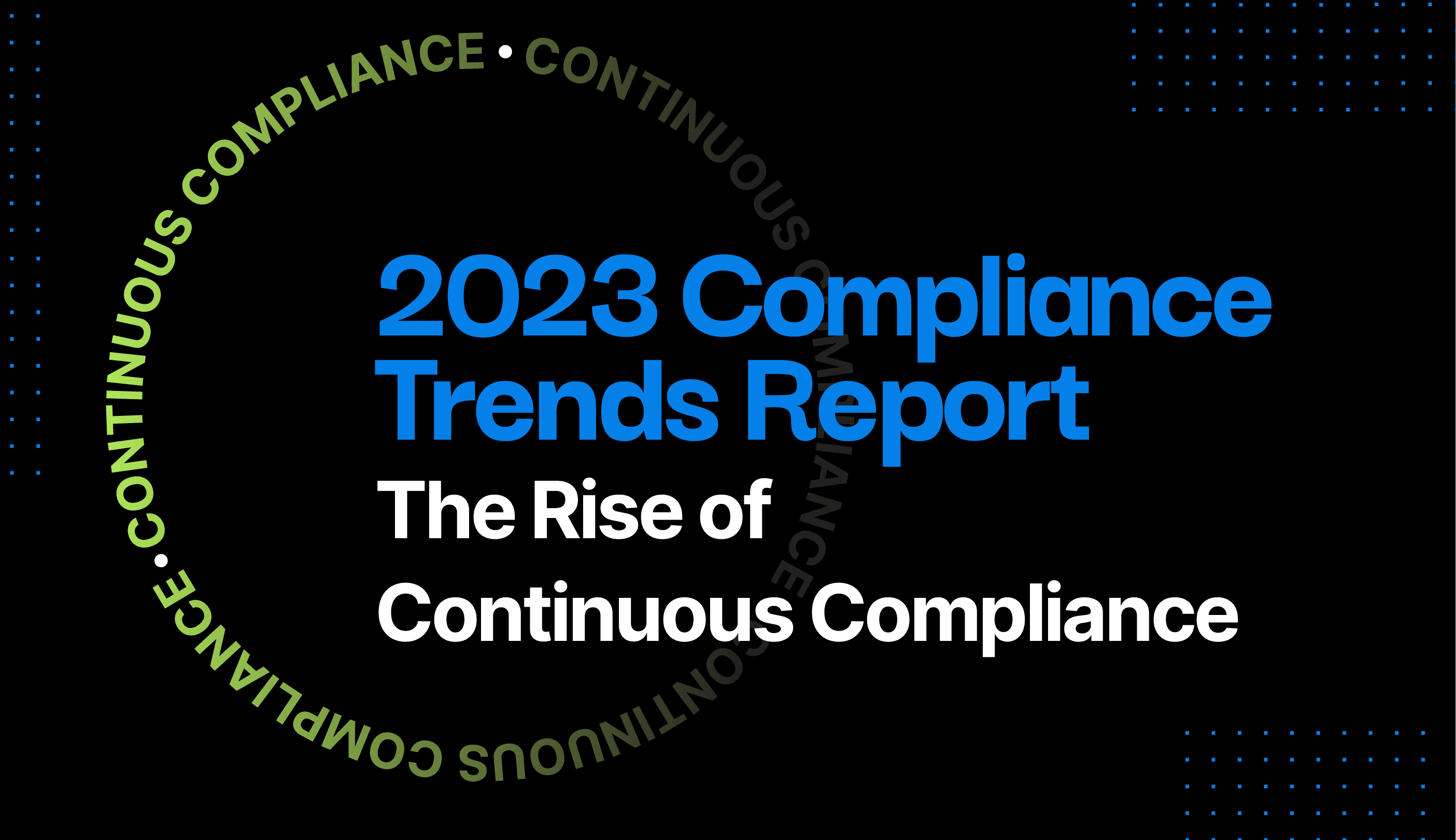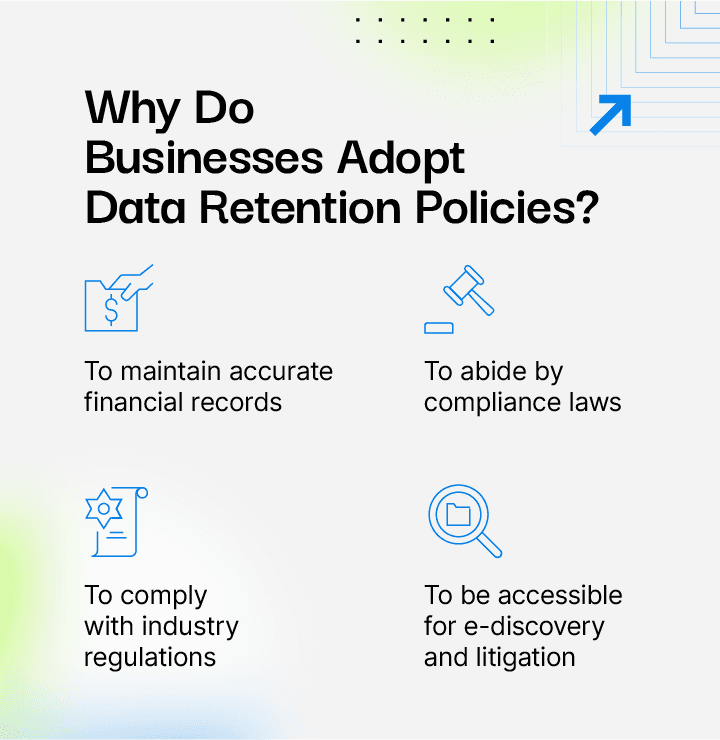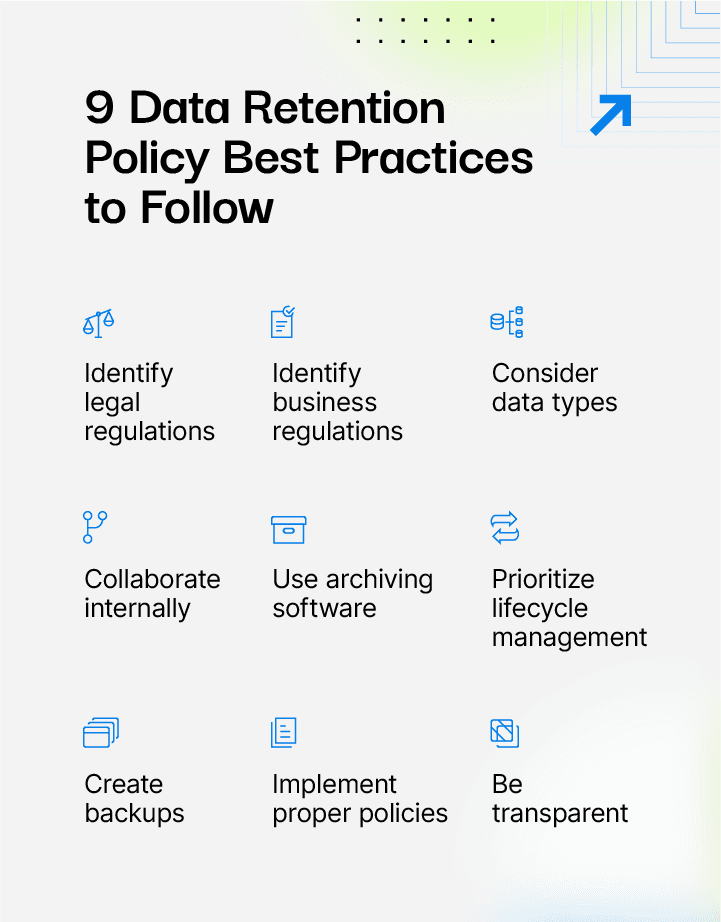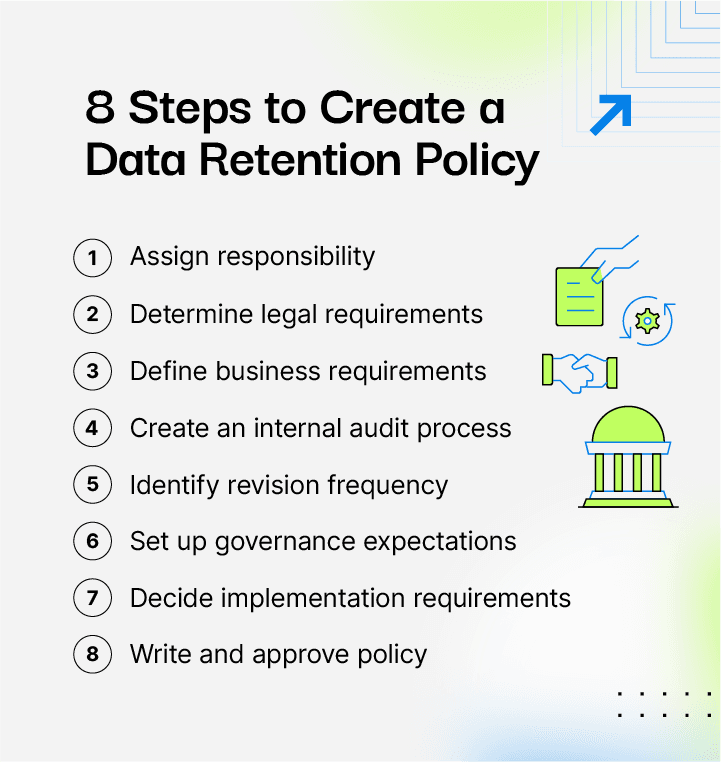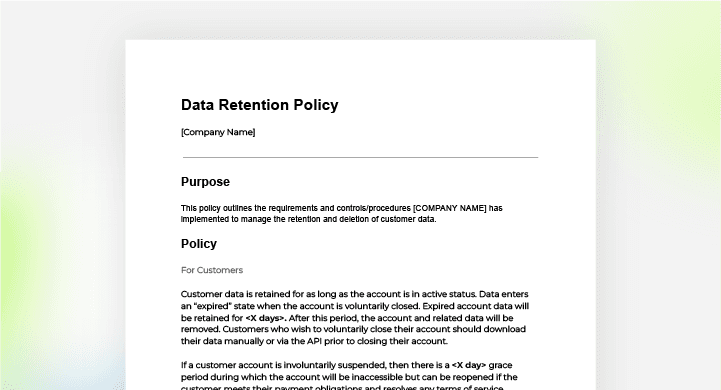What Is a Data Retention Policy? Best Practices + Template
Find out everything you need to know about data retention policies and get your hands on a free template.
Your data is a precious commodity. However, if, like most organizations, you’re managing more than 500 petabytes of emails, board reports, payment information, and private contracts, that volume becomes a burden rather than purely an asset. Businesses can’t keep all of that data forever, nor should they.
Data retention policies eliminate the guesswork involved in managing so much information. They provide the framework that tells you and your team what data to keep, where to store it, and for how long. Plus, with regulations and privacy laws making data retention and deletion processes mandatory for many industries, the need for structured information storage should be a priority for any growing business.
Dive into our article to learn more about data retention best practices and challenges, and how to create a policy (plus, get access to a free template).
What Is a Data Retention Policy?
A data retention policy is a company’s protocol for maintaining data in accordance with regulatory and contractual obligations.
Also known as the records retention policy, your data retention policy is part of your larger GRC and privacy program. It clarifies data handling and holding timelines, storage system requirements, and data formations, which will depend on the regulations that apply to your organization (such as HIPAA for health-related industries or the GDPR for those doing business in the European Union). It highlights the reasons you should keep certain data, where those documents should be kept, as well as when and how they should be deleted from your systems.
A byproduct of a strong data retention policy is establishing how your business should collect and store specific types of data. Your policy forces you to think about the full data lifecycle and be intentional about what data you actually need and how it should be stored.
Why Is a Data Retention Policy Important?
A data retention policy provides your business with specific data management guidelines. This ensures data is only kept as long as necessary, which mitigates risk, frees up storage space, improves organization, and increases efficiency.
Automatic Compliance
A strong retention policy means you're already meeting GDPR's "right to be forgotten" requirements, HIPAA's patient data rules, and SOX's financial record timelines.
When regulators ask, "Can you prove you delete personal data after three years?" you can actually say yes and show them how, instead of frantically looking through backup drives and hoping for the best. Your legal team will thank you, and your audit prep goes from months of chaos to a simple policy walkthrough.
Reduced Fines
Adhering to data storage and retention requirements minimizes fines associated with non-compliance. For one, your policy and its resulting workflows take into account the requirements of any applicable laws, which automatically reduces the chance of violations. For example, if you’re an online retailer with customers in the European Union, your data retention policy will outline when personal data is deleted in accordance with GDPR, so you’re less likely to be fined.
Also, bad actors can’t get their hands on data you don’t have. Data that no longer exists can't be compromised in a breach, so regular deletion decreases both your compliance risk and your exposure to expensive data incidents.
Reduced Storage Costs
Data accumulates relentlessly: customer records, transaction logs, employee files, and system backups all pile up year after year without intervention. A retention policy tackles this growth systematically through deletion schedules for different data types and by moving older, less critical information to cheaper storage tiers.
Plus, it prevents storage sprawl while optimizing your infrastructure spend. Instead of paying premium rates to store five-year-old email attachments on high-performance drives, you're investing those resources in data that actually drives business value.
Increased Relevancy
When employees search for customer data, they shouldn't have to wade through records from clients who left three years ago. Retention policies automatically purge outdated information, leaving behind the current, actionable data that actually matters for day-to-day operations. You’re left with cleaner search results, more accurate reports, and analytics based on relevant rather than stale information. In short, you get the signal without the noise.
Decreased Legal Discovery
Legal discovery is expensive because lawyers have to review everything, including years of irrelevant emails and outdated files that have nothing to do with the case. However, if you systematically delete old data, there's less material for opposing counsel to request and for your legal team to sift through.
Such processes cut discovery costs significantly and decrease the chance that some embarrassing three-year-old internal memo gets dragged into court proceedings. Courts also view proactive data management favorably, since it shows you're following standard business practices rather than trying to hide evidence.
Enhanced Recovery
If a time comes when your systems crash, every minute of downtime costs money. A retention policy assists recovery efforts by ensuring your backup systems only contain current, necessary data rather than years of digital debris.
IT teams can identify and restore what's actually missing without sorting through obsolete files that should have been deleted long ago. Less clutter equals faster recovery and shorter outages.
What Is a Data Retention Period?
A data retention period is the amount of time an organization stores data. Retention periods vary by data type, but should be long enough to meet the business needs without becoming a liability. For instance, tax records must be kept for seven years, while server logs are retained for one year.
Laws like GDPR, HIPAA, and the Payment Card Industry Data Security Standard (PCI DSS) also dictate the timelines for keeping certain types of data, and may be required depending on your industry. Business needs may also call for a specific data retention period; for instance, a SaaS company may keep support chats for two years to document long-term trends in product usage and customer service.
How Long Can Data Be Kept?
Data storage and retention limits depend on the type of information you collect, its intended use, regulations governing that information, and contractual obligations. Once data fulfills its purpose, archive or delete it based on regulatory or business rules.
Regulatory Requirements
The different regulations that apply to your industry or the type of data collected affect how long you should keep a specific type of data. Some regulations dictate a minimum amount of time to store data, and some specify a maximum. For example, the PCI DSS outlines specific data storage requirements to make sure credit card information is processed and stored securely. If there is a recorded and authorised business need, credit card information storage may only occur until the data is processed. It must then be destroyed.
Other regulations provide similar guidance. HIPAA requires healthcare providers to retain documentation for at least six years, while SOX mandates that financial records be kept for seven years. In contrast, privacy regulations like GDPR require organizations to delete personal data as soon as it’s no longer necessary for the purpose it was collected.
Below is an overview of data retention timelines mapped to security frameworks. Use it to understand baseline requirements for your industry and identify which regulations apply to your specific data types.
Framework | Example of Covered Data Types | Typical Retention Guidance | Notes |
GDPR | Personal data (EU citizens), including customer and employee data | No fixed period, data must be kept no longer than necessary for the purpose it was collected | Requires justification for retention periods |
Audit evidence including logs, monitoring data, access records, and compliance documentation | One to three years for logs, monitoring data, and access controls as a best practice | AICPA does not prescribe specific retention; data must support controls and audit readiness | |
HIPAA | Patient records, claims, billing, and communications | Federal law states six years from the date of creation or last effective use, but state laws vary | State laws may extend or supersede this requirement; applies to covered entities and business associates |
PCI DSS | Credit card data, transaction logs, and authorization records | Sensitive cardholder data: retain only as long as necessary (typically deleted after processing); logs: minimum one year, with at least three months immediately available | Storing full cardholder data is prohibited unless absolutely required, and must be encrypted |
SOX | Financial records, audit workpapers, communications with auditors
| Seven years after creation or filing, whichever is later
| Applies to publicly traded U.S. companies and associated accounting firms |
Business Obligations
Your data’s use and storage lifecycle depend on its data classification and how it’s used within your organization. Business obligations, such as maintaining records for internal audits, resolving customer disputes, or tracking long-term contracts, often require data to be retained well beyond its immediate use.
Classified data with short storage timelines, like emails, can be configured for automatic deletion after 90 days. Other records, like contracts and authorizations, must be stored for years before archival or deletion, to meet operational or legal requirements.
Risk and Liability Considerations
Even if specific data doesn’t fall under regulatory requirements or business obligations, there may still be a liability associated with storing that information for an extended period. Holding on to data past its usefulness increases the chance that old or outdated data could be subpoenaed as part of a legal dispute. And the less unnecessary data you have, the less that can be exposed during a breach.
Data Retention Policy Best Practices
A good data retention policy meets both regulatory requirements and your organization’s practical needs. As you build your policy, keep these additional factors in mind.
Identify Legal Regulations
Research and identify applicable legal regulations that govern the data your organization collects, stores, and handles. Consult with your legal counsel to ensure all relevant laws are accounted for. Then incorporate these regulations into internal data retention and deletion policies to guarantee your organization abides by them.
Identify Business Obligations
In addition to the legal and business requirements, your data retention policy should consider the data classification and the types of information your organization collects, stores, and handles. Write policies and addendums that prioritize valuable data, specify what types should be retained, and clarify guidelines and timelines associated with each.
Consider Data Types
Data retention policies must represent the needs of an entire organization. Prioritize internal collaboration when creating and maintaining retention policies to uphold laws and regulations for multiple organizational branches and business units. Include internal legal, finance, and IT teams in the drafting process to create a comprehensive policy.
Collaborate Internally
Data retention policies must represent the needs of an entire organization. Prioritize internal collaboration when creating and maintaining retention policies to uphold laws and regulations for multiple organizational branches and business units. Consider including your internal legal, finance, IT, and accounting departments to create a comprehensive policy.
Invest in Archiving Software
If your data retention policy outlines unique storage timelines, you may want to consider investing in archiving software. An archival system frees up readily available storage space while maintaining the availability of archived data, which simplifies extraction, organizes information, and decreases storage costs. Archival software can also automate compliance and data lifecycle management.
Prioritize Data Lifecycle Management
Whether an organization is operating routinely or actively involved in litigation, data lifecycle management should be a priority. Adopt systems and structures designed to automate or pause the management process to reduce early data deletion and loss or interference.
Create Backups
Prioritize data security and regularly back up stored data. Updated backups will help keep your organization in compliance and ensure data availability. These backups can also reduce or eliminate the possibility of data loss due to outages, downtime, pauses, or other disturbances.
Eliminate data silos by including language that applies retention and backup standards to all storage locations, including laptops, personal drives, and third-party cloud tools. If data lives outside formal systems, it may be missed during backups or deletions.
Uphold Proper Policies
To achieve regulatory compliance, organizations must document data retention requirements. Draft and maintain formal documents outlining these requirements, and consider creating additional documentation that you can distribute more widely. Update these documents regularly with requirement changes to satisfy mandates and educate stakeholders.
Be Transparent
Communicate with your customers and stakeholders. Don’t hide your collection efforts, and be forthright about your policy regulations. Allow your customers to control their data usage where possible and provide simplified copies of your data retention policy to users.
What are the Challenges Associated With Data Retention Policies?
Data retention policies significantly reduce information collection and storage challenges. However, stringent policies still come with drawbacks.
Data Disposal
Deleting data sounds simple, but in practice, it's a major compliance risk. Files get renamed, copied to personal drives, or moved to folders outside of retention workflows, accidentally extending their lifecycle. Even automated deletion tools fail if teams don’t follow naming conventions or store data in the right places (for example, a file marked for deletion after 90 days is moved to a shared folder on day 85. The system treats it as “new” and resets the timer, keeping it longer than your policy allows).
What to do:
Enforce strict storage and naming conventions to avoid accidental resets.
Run quarterly audits to flag files that should have been deleted.
Educate employees on how everyday habits (like duplicating files) can break compliance.
Storage
Your organization will only produce more data as it grows. Customer records, email archives, debug logs, backups, employee documents…even systems designed for temporary storage often become long-term dumping grounds. Without clear deletion rules, cloud costs rise, systems slow down, and legal risk increases.
What to do:
Review high-volume data sources quarterly and flag anything unrelated to legal or operational needs.
Set expiration dates on data types prone to sprawl, like logs, recordings, and drafts.
Retention Schedules
No single retention rule fits everything. As we saw above, financial records might need to be kept for seven years while customer data under GDPR has to be deleted as soon as it’s no longer needed. Add state laws, client contracts, or industry standards, and you’ve got a mess of overlapping timelines.
What to do:
Classify data by type (e.g., financial, customer, operational) and tag it with applicable regulations.
Use policy management tools that apply timelines automatically based on these tags.
Revisit schedules yearly to keep pace with regulatory changes and your company’s growth trajectory.
Tool Sprawl
Different teams use different tools, and each tool becomes a silo (e.g., engineering logs everything in GitHub and Jira; meanwhile, marketing has cloud folders full of leads, creatives, and campaign data). If every system manages data differently, enforcing consistent retention policies is a losing battle.
What to do:
Inventory your tools and map what types of data each team stores.
Standardize retention rules across systems (or at least, set minimum expectations).
Use integrations or APIs to apply automated rules where possible.
Lack of Alignment Between Legal and Technical Teams
Legal teams want to keep data longer for defensibility, while engineering teams want to delete data sooner for performance and risk reduction. Without alignment, policies become either too strict to implement or too weak to protect the business.
What to do:
Bring both teams into the policy development process.
Agree on data categories that merit long-term retention and those that don’t.
Build exceptions into the policy for technically burdensome cases and revisit them as systems evolve.
Static Retention Policies
Your data retention needs grow with your organization. New tools, new regulations, mergers, product launches, or entering regulated markets all affect what data you collect and how long you must retain it. Yet, it’s all too easy to write a data retention policy once and leave it to age quietly.
What to do:
Review your retention policy at least annually or whenever your business model, tools, or markets change.
Assign ownership. Someone (not “everyone”) should be responsible for updates and cross-team coordination.
Use version control and track policy changes over time.
How to Create a Data Retention Policy (8 Steps)
While many organizations outsource the creation of a data retention policy, it’s certainly possible to outline and implement one internally. Here’s how to design your policy:
1. Assign Responsibility
To design a data retention policy, you need a team of industry experts. Assign a team of individuals with information technology and legal expertise from across your organization. This team will be responsible for the policy’s research, creation, and implementation.
2. Determine Legal Requirements
A record retention policy must meet or exceed the expectations required by external data regulations. Require your policy team to consider the timeframes outlined within these documents before suggesting guidelines for internal documents.
3. Define Business Requirements
While data regulations drive retention timelines, so do business requirements. Consider how long your organization needs to use and maintain information and work these timelines into your policy guidelines—especially if your needs exceed legal retention requirements. At this stage, it’s also best to identify and incorporate archival timelines and disposal expectations into your guidelines.
4. Create an Internal Audit Process
Identify and classify the data your organization stores. Recognize the storage and archival timelines your organization must adhere to and audit your current management processes for gaps where your company is non-compliant with regulatory frameworks and industry laws.
5. Identify Revision Frequency
To stay compliant, you need to update your data retention policies when compliance laws and regulations change. Identify when your team needs to focus on policy reviews following any changes on regulations and/or contractual compliance requirements. Consider also creating dedicated timelines or assigning the responsibility for emergency policy updates to ensure continued compliance.
6. Set Up Governance Expectations
Collaborate with HR teams or legal departments about policy enforcement. Your organization should write governance policies outlining team expectations, information collection and storage guidelines, and archival and disposal projections.
7. Decide Implementation Requirements
In addition to governance expectations, outline your team’s implementation requirements. This should include when and how your data retention policy takes effect. Be sure to also clarify and include information collection, handling, storage, and disposal timelines within your policy’s implementation requirements.
8. Write and Approve Data Retention Policy
After collecting and analyzing your preliminary expectations and requirements, write a formal data retention policy. Consider your team’s needs and compliance laws equally to design a flexible yet authoritative document. This policy will need to be approved by your organization’s key internal and external stakeholders before implementation can begin.
Data Retention Policy Template
Creating a data retention policy doesn’t have to be overwhelming. A well-structured template helps you define legal timelines, meet business needs, and reduce risk without starting from scratch. Need a little head start? Download our free template.
Support Your Data Retention Policy With Drata
Your organization’s data is a valuable resource—except when it’s not managed well. Then, it becomes a liability. With a Trust Management platform like Drata supporting your data retention policy, you can automate enforcement, reduce manual oversight, and always stay audit-ready.
We give you full visibility into what data you have, where it lives, and how long it should be kept. Built-in integrations connect to your tech stack, while automated controls track retention requirements across frameworks. You can forget about scattered spreadsheets, forgotten files, or outdated timelines.
Start automating your policy enforcement with Drata. Schedule a demo with our team.
Data Retention Policy FAQs
Below, we answer the most common questions about data retention policies.
What is the Meaning of Data Retention?
Data retention is the practice of storing information for a specific period, based on legal, regulatory, or business requirements, and securely disposing of it when it’s no longer needed. The goal is to ensure that data is available when required (for audits, legal obligations, customer support, or analytics) and removed when it’s no longer relevant, to reduce risk, costs, and potential exposure in the event of a breach
Retention applies to all forms of data, including emails, contracts, customer records, system logs, and backups, and must cover both structured systems (like databases) and unstructured content (like spreadsheets or PDFs).
Do I Need a Data Retention Policy?
Yes, if your organization collects or stores any data, you need a retention policy. That includes customer records, employee files, vendor contracts, internal communications, and more.
Even if regulations don’t explicitly require it, a retention policy helps you:
Reduce legal risk by ensuring outdated or unnecessary data is deleted.
Improve efficiency by limiting what you store and where you store it.
Prepare for audits with clear rules on what data is kept and for how long.
Build trust by showing customers and partners you take data governance seriously.
How Long Should Data be Retained?
How long you retain data for depends on the type of data, regulatory requirements, and business needs. There’s no universal retention period; as a best practice, you should define retention timelines by data category, document them, and review them regularly.
What is the Data Retention Policy as per GDPR?
Under the General Data Protection Regulation (GDPR), one key principle is storage limitation. This means personal data should only be kept for as long as necessary to fulfill its original purpose. Once that purpose is met, the data must be securely deleted or anonymized.
GDPR doesn’t set fixed retention periods. Instead, it requires organizations to:
Justify how long they keep each type of personal data.
Define and document those timeframes.
Regularly review and delete data that’s no longer necessary.
For example, if you collect customer contact information to deliver a service, you should delete that data once the service is complete, unless you have another lawful reason to keep it (e.g., invoicing or legal obligations).
What is a Good Retention Policy?
A good data retention policy strikes the right balance between legal compliance, business needs, and operational practicality. The main traits of a strong retention policy are:
Data classification: It organizes information by type (e.g., financial records, customer data, emails) so each category has clear rules.
Retention timelines: It defines how long to keep each type of data based on legal, regulatory, or business-specific requirements.
Deletion procedures: It includes workflows for securely deleting data when it’s no longer needed, across live systems, backups, and archives.
Consistency: It applies rules across cloud services, local storage, email systems, and third-party platforms.
2023 Compliance Trends Report
Drata surveyed 300 established and enterprise organizations to tap the pulse of the state of risk and compliance. In doing so, we identified related trends, perceptions, and how compliance impacts the business. This year, the primary takeaway is that a mature compliance program will accelerate a business, not slow it down.
